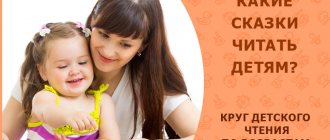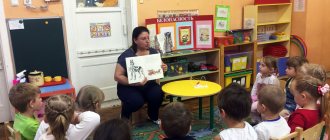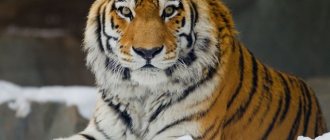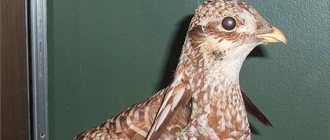Short texts for reading grade 1
To help your child read better, select short, interesting texts for him. They should be understandable to the child and the events in the texts should be close to him.
If we consider that reading standards in first grade are from 20 (at the beginning of the year) to 40 (at the end of the year) words, then the texts should be small, 50-100 words, that is, 5 minutes of reading. Five minutes is taken because it is still difficult for a child to read; for him it is a lot of work.
It’s good if there are questions about the text: by answering them, the child improves his reading awareness and understanding of what he read.
Text author: Svetlana Kononova
Cat and kittens
The cat has kittens. Two cheerful red-haired naughty girls. One kitten climbed onto the mother cat and began to pull her ear. The cat tried to reach him with her paw, but he dodged. He jumps on mom again and wags his tail. The second kitten saw his brother's tail and wanted to grab it. But the tail moves and does not give. Then the second kitten attacked his brother and caught his tail. The cat got tired of the kittens' pranks, got up and went to the chair. There she calmly fell asleep, and the kittens could not reach her.
(82 words)
Tea
Did you know that tea originated in China as a medicinal drink? And only later did tea drinking begin to come to every family. But China is far away, but tea is here, in front of us. How does he get to us? Tea is collected, and the most tender leaves from the bush are taken. Then they are dried and put into bags. And to bring it to us, a ship with tea travels many, many kilometers across the sea. The tea must be transported carefully; not a drop of water should get on it! At the tea factory, tea is packed into boxes. There are different types of tea: black, green and even white. Each box must be signed so that in the store we can choose exactly the tea we love.
(107 words)
Coins
Tolya collects coins. No, he doesn't look for them on the ground or on the sidewalk. He looks at the coins his dad gives him. And dad is given them as change at the store. Tolya has different coins with different numbers on them. And the coins themselves are of different colors and sizes: light and dark, large and small. There are new coins, and there are old ones. You can't buy anything with old coins; they no longer work as money. The boy also has coins from different countries. After all, in different countries different money and coins are different from those that we see every day.
(96 words)
leaf
Tanya brought a piece of paper from the street. It was yellow on one end and orange on the other. I really want to draw a leaf like this. It is bright and colorful. Tanya took brushes and paints and brought a sheet of paper to the table. First, she placed the piece of paper on a piece of paper and traced it with a simple pencil. The result is the outline of a leaf. Now we need to add color to it! Tanya moistened the sheet with water and put yellow paint on her brush. One two Three! She pressed the brush in different places on the painted leaf. The paint has faded a little. Tanya picked up orange paint on her brush. One two Three! Tanya painted everything else orange. The leaf turned out very bright. Then the leaf dried and the girl drew veins on it with a brown felt-tip pen. And then I cut it out. It turned out to be a real autumn leaf!
(112 words)
Ball
Anya saw a ball in the store. It was green on one side and red on the other. And on the side of the ball there was a butterfly drawn. Mom bought this ball for the girl and Anya took it out into the yard. She was playing with a ball, but she threw it too high and the ball accidentally fell on a flower bed. The ball rolled out on the other side and Anya took it home. And in the evening the girl was putting away the toys and saw that for some reason there was no butterfly on the ball. Where did the butterfly go?
(79 words)
Seed and pea
Katya had a seed, and Vitya had a pea. The seed was black and glossy, and the pea was hard and round. The children decided to plant a seed and a pea in the ground. They took cups, poured soil into them and each put their own seed. Then they sprinkled the seed and pea with soil and watered it. The children placed pots with black soil and seeds on the windowsill. The sun warmed the glasses, Katya and Vitya did not forget to water them. And soon the children’s pots sprouted stems and first leaves. The stems became stronger and the leaves became larger, and the children planted the plants in the garden bed. Vitya grew sweet peas. And Katya grew a beautiful sunflower.
(100 words)
You can also read alternately with your child. I think short fairy tales are good for this. For example, in Vladimir Suteev’s fairy tale “Under the Mushroom” there are only 269 words!
Your Svetlana Kononova, methodologist of the Miracle Child online school
More reading with your child...
- Under the mushroom. In Suteev A tale of friendship and how mushrooms grow in the rain. You can download the text of the fairy tale in large font for reading at the bottom of the page. Text of the fairy tale Under the Mushroom. In Suteev One day Ant was caught in heavy rain. Where to hide? The Ant saw a small fungus in the clearing, ran to it and hid under its hat. Is sitting…
- The Fox and the Wolf (Russian folk tale) This Russian folk tale is also sometimes called “The Fox-Sister and the Wolf.” In the fairy tale, the wolf, on the advice of a sly fox, caught a fish in an ice hole with his tail. In order to make it more useful for you and your child to read, at the end of the fairy tale you will find a link to materials useful for reading it, which Irina Nazarova prepared for you. Text…
- Little foxes. Evgeniy Charushin The fairy tale is about two fox cubs who lived in a hunter’s house. Evgeniy Charushin himself drew illustrations for his stories and he produced amazing fluffies. You and I will draw using the same technique. Reading text, master class on drawing "in the style of Charushin", a fairy tale by syllables, video tutorial...
The first books for independent reading (after the primer or during its development)
Hi all!
Today I have prepared a review of books (as well as series of books) from which our 4-5 year old children will be able to acquire their very first reading skills. First books for independent reading
It is very important to choose the right one - your choice will directly determine whether your child will love reading, whether it will be easy for him, and in the long term this will affect his studies at school!
So, let's look through the pages of such books!!!
In this post we will look at books of 3 categories:
1. Specially published books for the first independent reading WITHOUT_DIVIDING_WORDS_INTO_SYLLABLES;
2. Specially published books for the first independent reading WITH_DIVIDING_WORDS_INTO_SYLLABLES;
3. Books that were not published specifically for independent reading, but are quite suitable for these purposes.
I will also list the main characteristics by which I myself tried to choose books for my daughter’s FIRST INDEPENDENT reading.
(sometimes, however, she departed from them a little):
1. The text of the book must be printed in large font
Some people are skeptical about this point, but I have personally seen that with such a font, reading is easier for children - my daughter told me about this herself!
2. White background is welcome!
Everything is obvious here - the darker, brighter and more colorful the background - the more difficult it is to read.
3. Short stories with little text per page
The child must see and “feel” that the text is not endless and is within his capabilities.
4. Words and sentences from them should also be short at first
We will complicate things, but not right away 
5. Pleasant illustrations must be present
Don't forget that reading at this age is a game!
6. Preference for thin books
Practical point - it is more convenient for a child to hold and, in principle, interact with a book;
Psychological moment - increased self-esteem - “I read the whole book MYSELF!”
7. Interesting plot (simply super if it resonates with the interests of the child)
Reading should be fun and bring joy! Then you won’t have to further motivate the child.
==
I will assign a rating to each book (series of books) that will be discussed in the review based on all of the above characteristics. The more criteria a book meets, the higher the score. Thus, the highest score will be 7 points.
BOOKS WITHOUT DIVIDING WORDS INTO SYLLABLES
1. “Whose side” series from Tatyana Russita (super - score 7 out of 7)
The series of 8 books is incredibly fun and mischievous. I can’t imagine any child who wouldn’t like these books—I just can’t!!! Eh, why wasn’t she there when we were learning to put letters into words...
Series of books “Whose Side?” in the Labyrinth, My-shop, Ozone, Read.ru
2. Books about Pip from the “Easy to Read” series (score 7 out of 7)
At the moment, the series consists of 2 issues (2 levels of difficulty), each of which contains 4 books for reading and 1 for entertainment. Pictured are those for reading
Pictured are those for reading
Start with the first (blue) issue - Pip and his friends.
“Just Read” series about Pip in the Labyrinth, My-shop (1 and), Ozone, Read.ru
3. Developmental course series “Reading after the ABC book” (score 7 out of 7)
A series of 3 books of varying degrees of difficulty. Let's start with green!
Series “Reading after the primer” in the Labyrinth, My-shop (, and), Ozone
4. Series “Short stories for independent reading” (score 7 out of 7)
Consists of 4 books (the last one is not in the photo), also of varying degrees of complexity.
We start with “Tanya is still small” from the stories of L.N. Tolstoy.
Series “Short stories for independent reading” in Labyrinth, My-shop (, , ,), Ozone (and), Read.ru (, , , )
ATTENTION!
All 4 books in the “Short Stories for Independent Reading” series under one hard cover can be bought in this edition (the stories and pictures are 90% duplicated - there are a little more of them in the thin ones):
The book “First books on reading” in the Labyrinth, My-shop, Ozone, Read.ru
5. Series “Reading after the primer” (rating 5 out of 7
— reduced for font size and size of some stories).
The texts in the series are very different, see the photos in the Labyrinth for each book!!!
Series “Reading after the primer” in the Labyrinth, My-shop, Ozone, Read.ru
6. Series “I can read. Short Stories" (rating 6 out of 7
- reduced for some bad background)
The texts in the series are very different, see the photos in the Labyrinth for each book!!!
Series “I can read. Short stories" in Labyrinth, My-shop, Ozone
===
AND NOW BOOKS THAT ARE NOT INTENDED FOR INDEPENDENT READING, BUT ARE VERY SUITABLE FOR IT
7. The fox and the mouse are just perfect! (score 7+ out of 7)
This book is ideal for our purposes. Moreover, you can beat her and read her roles!!!
Book “The Fox and the Mouse” in the Labyrinth, My-shop, Ozone
8. A series of books about Masha (score 6 out of 7
— reduced a little due to the small font)
Series about Masha in the Labyrinth, My-shop, Ozone, Read.ru
9. Series about the Mouse (score 6 out of 7
- reduced for background)
The books in this series, it seems to me, are very close in content to the lives of our children, and this is their main charm.
Series about the Mouse in the Labyrinth, My-shop (, , , ), Ozone, Read.ru
10. Series “Little Tales” (score 6 out of 7
- reduced for content)
11. Series about Meowli (score 6 out of 7
- reduced for content)
Series about Meowli in the Labyrinth, My-shop, Ozone and Read.ru
12. Series about Shmyak (score 6 out of 7)
Personally, my child squeals with delight at books about Shmyak and reads them to me with particular pleasure :)))
Series about Shmyak in the Labyrinth from Rob Scotton and in the Labyrinth from Lin Shu, My-shop, Ozone 1st series and Ozone 2nd series, and Read.ru
Books about Shmyak were marked by the publishing house Klever with this icon
:
Please note that Clover also marked these (and many other) books with the “I Read Myself” icon (PICTURES ARE CLICKABLE):
In addition, recently a series of books have appeared in other publishing houses, which, in my opinion, should also be well suited for the first independent reading. Here are some of them (PICTURES ARE CLICKABLE!):
===
Let's move on to BOOKS WITH DIVISION INTO SYLLABLES
We have very few such books at home. I heard that experts advise children who have trouble understanding the division of words into syllables to read just such books. But in my opinion this does not apply to my child. On the contrary, it seemed to me that in such texts my daughter is less able to navigate where one word ends and another begins. Therefore, quite quickly we turned off “our reading by syllables” and moved on to the more standard books mentioned above. However, I will still note a couple of series with division into syllables that I liked.
13. Series “First reading. Reading syllable by syllable" (score 6 out of 7)
This series includes books with both short stories and long ones. We didn’t get to the long ones, moving on to the classic texts.
We start the series with the Jolly Farmer!
The texts in the series are very different, see the photos in the Labyrinth for each book!!!
The entire series “First Reading. Reading syllable by syllable" in Labyrinth, My-shop, Read.ru
14. Series “Reading by syllables” from the publishing house AST (score 6 out of 7)
The series features classic poems and fairy tales that your baby has probably already heard before - the easier it will be for him to read them 
Series “Read by syllables” from the publishing house AST in Labyrinth, Ozone
We will also talk about more serious thick books on which our children will improve their first reading skills (such as Kwak and Toad), but a little later - in subsequent posts.
==
I have a question for mothers of children who are already reading: what first reading books were hits with your child? Share!






